I have been keeping Tropheus cichlid tropical fish from Lake Tanganyika for many years now and with a spare 240 litre Fluval Roma 240 aquarium I decided start a breeding project for Tropheus Kaiser Ikola as these have always been one of my favourite Tropheus cichlids and in my top tropical fish of all time list.
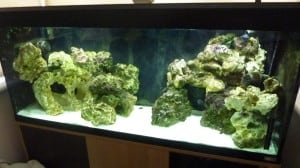
This project started off, as expected, with the planning of what I wanted to achieve ultimately which is to have a strong and healthy breeding group capable of bringing regular batches of fry. The various options of the fish to buy were considered. The first consideration was to buy wild caught tropheus through one o the various reputable importers in the UK. I have bought various batches of wild caught tropheus over the years and had some bad luck with them which I partially put down to experience of keeping wild caught fish and partially to buying from non-reputable and bad sources. Whenever I have kept and successfully bred tropheus fish in the past, the vast majority (95% plus) of the fry have survived and lived to become healthy adults. This indicates to me that raising tropheus from fry in the same environment that they will become an adult group brings greater success rates. The only issue with this is the time it takes for the fry to grow on to an adult size where they will be mature enough to breed. This time scale is often quoted at around 12-18 months however I have found ways to increase growth rate without having an adverse affect on the health of the fish. So with this in mind I settled on buying F1 fry. These were sourced from 3 different breeders at different times and had all come from different mothers/batches so the chances of mixed blood lines was greatly increased ensuring healthier fry would be produced from them further down the line. Here is a video of the smallest of the fry which I kept separate from the rest of the fish when first purchased in a breeding net as I thought they would be too small to survive in the tank. For 2 weeks I added crushed spirulina flake as often as possible each day (sometimes 7-8 times) which got them in to a routine of eating as regularly as possible.
Tropheus cichlids are herbivores which graze on algae growth on rocks in the wild and will do so for 90% of their time so it is unnatural to be feeding them once per day without giving them a secondary source of food. What better way to replicate the natural feeding routine and environment than to give them the option to graze for 90% of their time. This brings me on to how I planned to set up the most natural environment as possible.
The first key to increasing the algae growth would be the lighting. The cost effective way to do this is LED lighting and as I had already experienced using TMC Aquaray lighting I decided this would be the way forward. The initial outlay would be high however cost of electricity to run the lights would be significantly lower than having say 4 T5 lighting tubes. If you use a lot of lighting tubes you also have to consider the heat produced by them and maybe investigate getting an aquarium chiller, which are very expensive so I settled on TMC Aquaray LED Lighting.
After reviewing the TMC Aquaray range I settled upon 2x TMC Aquaray Growbeam 600 Ultra strips and 2x TMC Aquaray Marine White 600 Ultra strips. This may be seen as a lot of LED lighting for a 240L tank however this is the best combination to give a natural look, getting the shimmer effect and of course, to encourage algae growth. Mounting the LED’s was simpler than expected. I did consider adopting the Mountray system however this would have involved ether having an open top aquarium which I wanted to avoid due to unwanted evaporation. Of course I could have used some condensation covers but due to living in a hard water area the limescale soon builds up on condensation covers and for the best algae growth the lights need to be directly above the water surface. I picked up a couple of 1090mm TMC MMS rails and sawed off a few cms off the ends. These fitted snugly and nicely in to the original T8 lighting fixtures with no other modification required. The lights are also all powered by an TMC Aquaray 8 channel storm controller so that they can fade on at sunrise and off at sunset. The lights ramp up and down over a 30 minute period starting at 9AM and finishing at 11PM giving 14 hours of light, 13 hours of which are at full brightness.
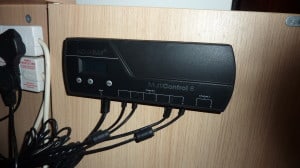
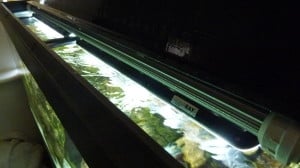
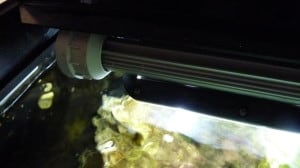
I wanted to replicate the fast flowing water and under currents experienced by the fish in Lake Tanganyika and so 2x Hydor 4000LPH powerheads were installed which initially I thought may be too high of a flow rate but with one at either end, this seems to do the job very nicely.
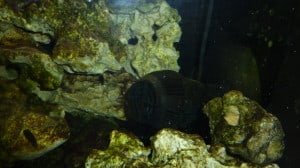
This brings me on to the filtration itself. I am a strong believer in having 2 of everything in case one breaks and you are not left panicking until you can get a replacement so I have over filtered this tank quite a lot by adding 2x Fluval 405 filters to it, each being stacked to the brim with JBL MicroMec filter media and the normal sponges down the side. These are then fed from 2 inline heaters which unfortunately I believe are no longer manufactured for some reason which is a shame as I think they are fantastic. I am talking about the Rena Smart Heater 300w.
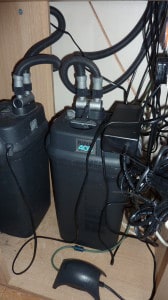
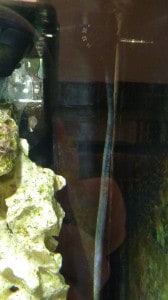
To give increased surface water agitation and aeration, a Tetratec APS50 air pump is used with the outlet airstone being attached to one of the filter outlets which pushes the air bubbles across the surface of the water.
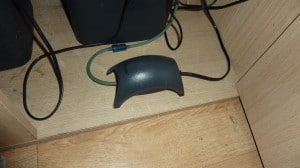
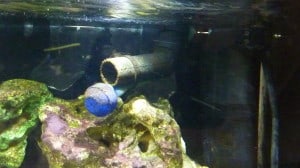
The final consideration was the aquascaping. I believe Tropheus prefer a lighter coloured substrate so I picked up some crushed coral sand produced by Unipac and then topped this off with some ocean rock. This is a sticking point for me, although the lake is naturally filled with very large boulders and rocks, the tank is tiny in comparison. With it in mind that fry are much more likely to survive if they have a safe place and hiding place to go to, ocean rock is ideal however the colour is not. Fear not though, our increased algae growth will soon change the colour and appearance of the rock and after a while it does look like one larger rock when stacked properly – problem solved. The last consideration with the aquascaping was whether to go for a 3D background or not. It was decided in this instance I would just black out 3 of the 4 sides with black background. This reduces reflection and gives the fish a more comfortable and natural environment if they are unable to see their reflection everywhere they look.
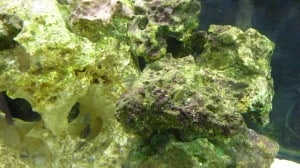
Going back to the fish, the quantity of fish purchased was a total of 37 fish. This is of course far too many to have in a 240 litre tank when fully grown however they will be fine with this level of filtration at this stocking level for at least the first 6 months before moving to a larger tank. I always prefer to buy too many fish in case you do get hit by a disease and lose some of them and when buying fry always realise that some may naturally not make it to adulthood. Yes, 37 is excessive but if I end up with a group of 20-30 adults from this then it is successful. If we started with 15-20 say and lost some along the way then end up with 7-10 then this is not ideal for an adult group. I would recommend always having an adult group of at least 15.
Here are a few images and a video of the tank after being up and running for 1 month.
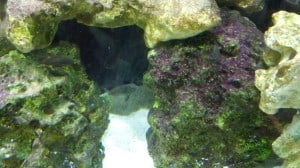
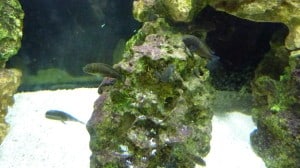
After keeping them for around a month now I have not yet had a casualty so all is going well so far and i am pleased with the result of the way the aquarium now looks.

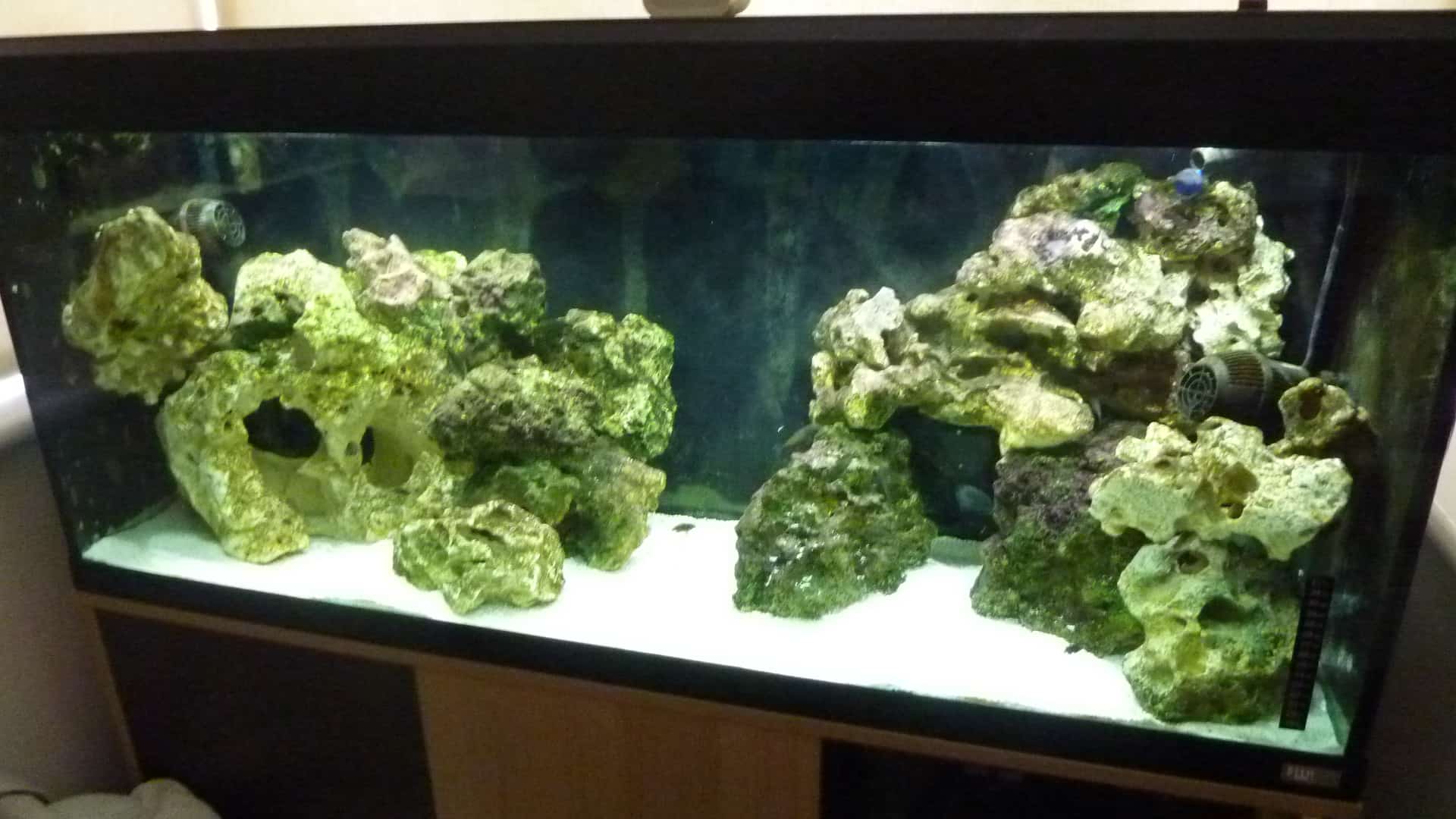
Related Posts
A Deeper Look In To Loach Fish Species
How Much Salt Should I Add To My Freshwater Aquarium
Everything You Need To Know About Using T5 Lights For Your Aquarium